What is the history of the Persian tiles ?
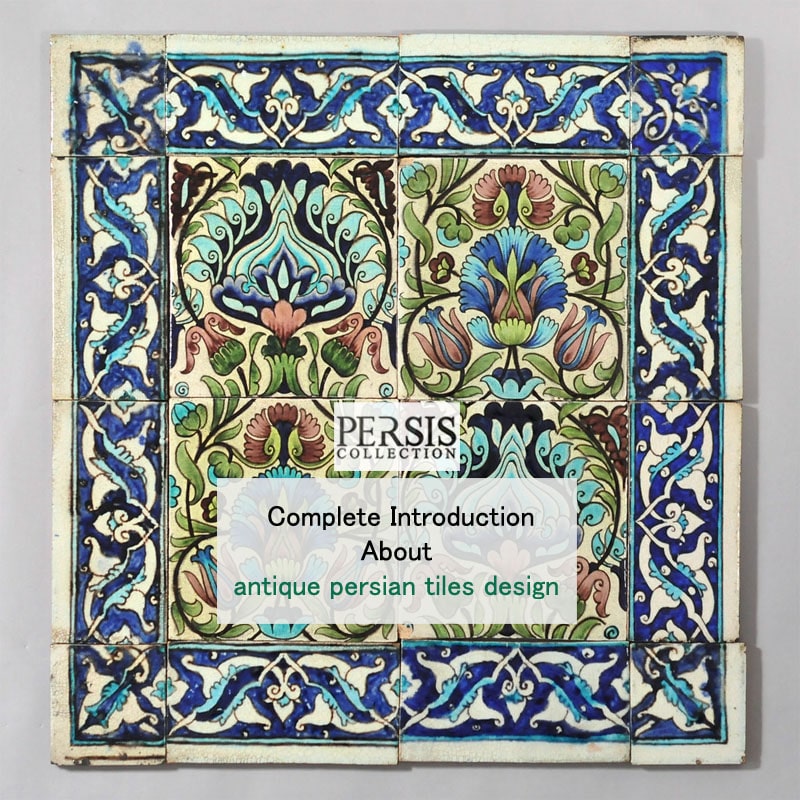
One of the authentic Iranian arts is making tiles, and one of its uses is to decorate the walls of mosques and places of pilgrimage. This article has been collected to familiarize us with the types of Iranian tiles so that when we go on a trip and visit historical monuments, knowing them will help us better understand the buildings and architecture. Persian tile has a very long history, which we will try to examine in the rest of this article. Therefore, today, we are going to provide you with useful information about this Iranian art. We suggest that you stay with the article section of the Persis Collection website for further educational articles about Persian tiles.
Persian tiles are glazed baked clays that are used to decorate buildings today. But if you want to know how artists achieved this art style, we have to look for its roots in pottery and the use of baked clay, which even goes back thousands of years. It is said that colored tiles have been found in Egypt dating back to 4700 BC.
However, the history of the use of glazed brick is currently attributed to Babylonian times (2nd millennium BC). Iranians also learned pottery and tile making from their neighbors and based on that, they created their own style. We can see examples of early tile making in Persepolis and the Achaemenid Palace.
In the Islamic period, when Iranian arts reached their peak, Persian tiles entered new styles. When we reach the Safavid period, due to the emphasis on decorations in architecture, we are faced with unique decorations of buildings with tiles, Like the decorated mosques of Isfahan, which make every viewer’s eye stare at itself. In the following, we will briefly examine the types of Persian tiles to get to know them better.
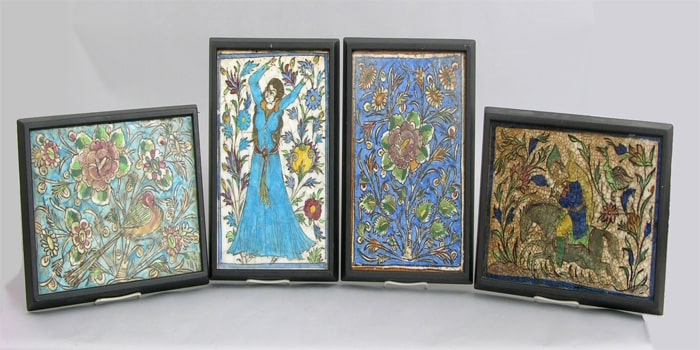
Persian ceramics
Types of Persian tiles designs
Persian tiles have various designs and colors that dazzle the eyes of every viewer. These designs can be clearly seen on the walls of mosques and buildings left from the Qajar period or earlier. Various types of tile designs were used in the walls and ceilings of many buildings of this period and gave a beautiful appearance to the walls and ceilings. In the following, you will learn more about the types of these designs.
Golden Persian tiles
Golden Persian tile refers to tiles that are made in golden or green color. Gold-colored tiles are strong and have a lower degree of firing. The tile is covered with white tin glaze, and after heating, it is painted with metal chloride.
Finally, the tile is placed in the furnace until it nears melting. The smoke created in the furnace marks the moment when brown motifs appear. These motifs later turn golden and green. This type of tile was mostly made in Kashan, Ray, Gorgan, Saveh, and Neishabur.
Golden tiles are a type of traditional decorative tile used in post-Islamic buildings. They were usually produced in green. To make them, artisans used clay along with flux and flint.
Golden Persian tiles came in many shapes, such as eight-pointed stars, six-pointed stars, crosses, squares, octagons, circles, and sometimes non-geometric forms placed next to inscription tiles. You can see these tiles mostly in buildings in Kashan, Ray, Gorgan, Saveh, Susa, and Neishabur.
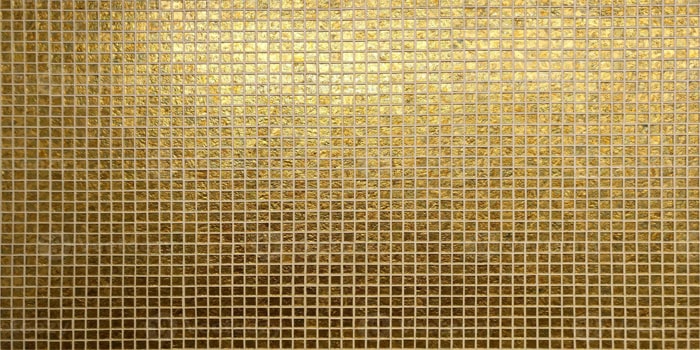
Golden Persian ceramics
Persian mosaic tile
Persian mosaic tiles are cut into large and small pieces, which are carved with different patterns and colors based on the design and put together to form a large piece. This tile style has been known as a mosaic among Europeans in the past. (Of course, there are some differences) In the Persian mosaic tile, white, dark blue, turquoise, green, and orange colors are usually used. The production workshops of this Persian tile are usually located in Isfahan, Mashhad, and, to some extent, Tehran.
After cutting and filing for the corners of the work where there is heterogeneity, it is time to arrange and stick the tiles on the mold. Of course, this is done according to the numbers on the tiles. To install the work in the desired place, they first make sure that it is dry. Then, it is attached to the wall with the help of special mortar, cement, sand, and water.
After finishing the work, they clean the design to fix any defects. In addition to historical buildings and mosques, mosaic tiles, which are one of the types of tiles in Iran, are used to decorate the walls of houses, photo frames, mirrors, and other such spaces.
In the past, some traditional patterned tiles, which had shapes such as flowers and Quran writings, were baked with the help of traditional ovens or small electric ovens. The production process of these types of tiles was simpler than today’s tiles. They used mud and soil to produce tiles and painted various designs on them with glaze. They were baked again in the same ovens to fix the color on them and then they were used.
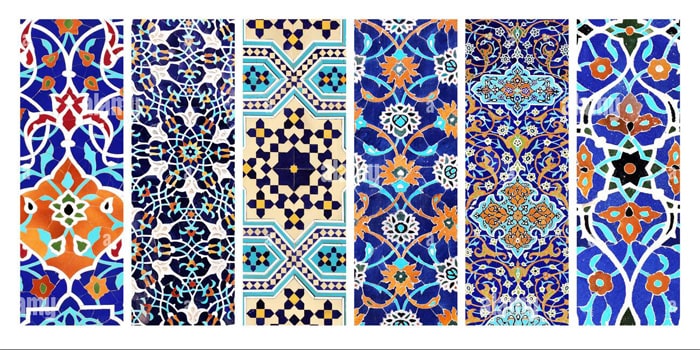
Persian mosaic tile
Moaqli Persian tiles
Moaqli tiles are made of very small dimensions and the work of Moaqli is done by placing these small tiles side by side. Sometimes, these tiles are combined with bricks, which prevents the expansion and contraction of the tiles in cold and heat, thus preventing the tile glaze from cracking and chipping.
In Moaqli tiling, they use all kinds of straight lines in the vertical and horizontal axes, and sometimes diagonal lines with a 45-degree angle and checkered. Usually, if Kufi lines are to be used in decoration, they use Moaqli tiles along with it.
This style of tiling can be seen in the buildings and mosques of Mashhad, the tomb of Mohammad Mahrooq in Neishabur, the Jame Mosque of Isfahan, and the head of the Mardin Mosque in Turkey. Like other types of tiling, Moaqli tiling requires a basic plan. For the design of this type of tiling, angular Kufi writing and lines based on chess houses are used. For example, in the tomb and mansion of Mashhad Mir Bozorg in Amol, you will see Ali’s name in the form of angular or masonry Kufi lines.
Persian Banaei tiles
This Persian tile style reached its perfection in the Safavid era. Persian Banaei tiles have geometric designs and are made by combining geometric shapes with an area of 4 to 8. Banaei tile designs are similar to Khatam, with the difference that only triangular shapes are used in Khatam, but both triangles and squares are used in Banaei tiles.
Each of the Banaei tile designs has its own name and official name. For example, the most famous of them are “Kand and Kalil”. This style of tile is made like a mosaic tile.
Persian enamel tile
This Persian tile is usually decorated with Eslimi, Khatai, and vegetable designs. It is mostly blue and is usually seen in older buildings. It has been common to use it on the exterior of the building. Traditional enamel tiling is also one of the decorative arts that have been used in the old buildings of Iran and dazzle the eyes of tourists.
Enamel tiles in old architecture were mostly blue, which are suitable for use in minarets or outside buildings. In enamel tiles, slime patterns, gilding, flowers and leaves, birds, intertwined curved lines, and small and large dots or diagonal lines are used a lot. The most common colors used in traditional enamel tiles are light blue, dark blue, red, yellow, brown, green, black, white, and turquoise.
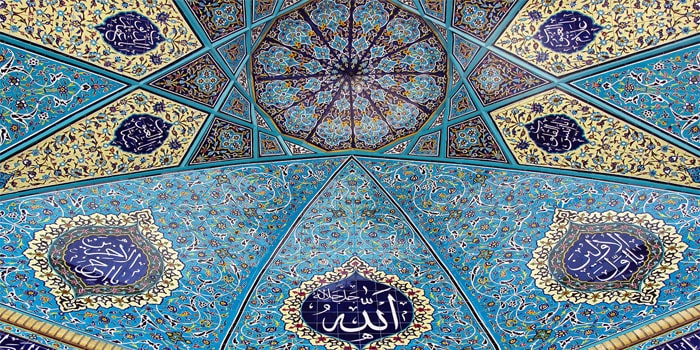
Persian enamel tile
Seven-color Persian tiles
Seven-color Persian tile is a contemporary tile style that became popular in the Qajar period. Some say this style emerged under the influence of Iran’s modernity and has lower quality than earlier tiles. It is made by combining fine and glazed clays. Each tile forms part of a larger design. These tiles have seven common colors, which are: azure, Persian turquoise, red, yellow, fawn, white, and black.
It has been said that Isfahan, Mashhad, and to some extent, Tehran are the centers of producing Seven-color Persian tiles.
The seven-color tiling has been remembered since the Safavid era and has been used in historical buildings, mosques, and tombs since ancient times. This type of tiling is more useful than other traditional tiling; It is also due to the use of various colors and the use of authentic Iranian motifs. In seven-color tiling, cement mortar, and water are used to install the tiles. Therefore, the resistance in this type of tiling is increased, and it will not be a problem against humidity.
The tiles used in this tiling are generally 20 x 20 cm in size, But mosques and domes use 15×7.5 or 20×10 cm tiles.
Seven-color tiling is more popular among Iranians due to the use of various colors and the use of authentic Iranian motifs.
In seven-color tiling, first, the design is drawn on paper. Then, the lines are recorded on the tile with the help of charcoal. In the next step, using glaze manganese oxide, and a little sap, the work of sticking and painting is done. After these steps are done, it is time to paint the tile. The meaning of seven colors in this type of tile are white, black, azure, turquoise, red, yellow, and fawn.
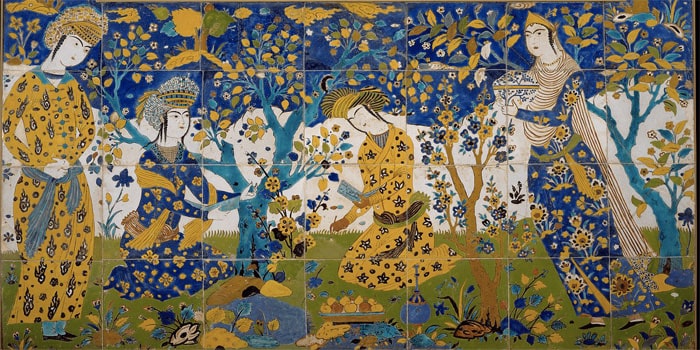
Seven-color Persian tiles
Moqarnas Persian tile
Muqarnas is one of the important decorative elements of architecture, which is used in the world to build buildings in the form of floors that are built on top of each other, to decorate buildings, or to make walls gradually change from one geometric shape to another. It is one of the important decorative elements of traditional architecture that are used to beautify buildings, tombs, mosques, and religious places in Iran.
They are very similar to beehives, and they are used in buildings that are built in the form of floors, to decorate the buildings or to change their geometric shape. The history of Moqarna’s work in Iran goes back to the pre-Islamic era and before the Achaemenid period.
Pasargad fireplace is an example of the art of Muqarnas in the Achaemenid era. After Islam entered Iran, Moqrans also preserved its identity and were used to decorate and build domes in beautiful buildings such as Shah Ismail’s Tomb and Kavus Dome. Nain Mosque, Ardestan Jame Mosque, Golpayegan Jame Mosque, Zavareh Jame Mosque, and Heydarieh Mosque in Qazvin are beautiful examples of the use of traditional Moqarnas tiles in Iranian architecture.
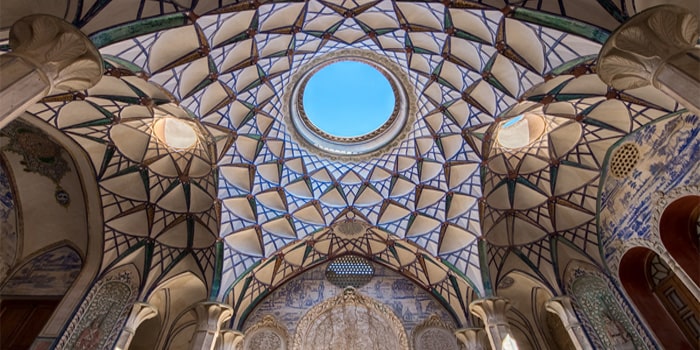
Moqarnas Persian tile
Mesh Persian tile
This type of Persian tile is arranged next to each other to create complex designs and is used to decorate the altar. Also, mesh tiles have been used as windows in the facing walls, which both bring the essential light into the room and prevent the nobles of the house from going outside.
The tomb of Jafar Esfahani, the tomb of Sheikh Safiuddin Ardabili, and the mosque of Sheikh Lotfollah Isfahan are among the most beautiful mesh tiles.
In this type of tiling, glazed tiles are cut to match the design. By placing them together, they form the pattern. Traditional grid tiles were used in historical buildings like markets, baths, and mosques. Along with doors and windows, builders often added a network of clay or tiles in the openings.
Mesh tiles were used in the architecture of old buildings for several reasons, some of which are mentioned below:
Iran’s changeable weather
- Strong sunlight to the building
- Providing lighting
- Space ventilation
- Wind and storm
- Special religious beliefs of Iranian people
- Decorative aspects
- Decorate the altars of mosques
These reasons have caused mesh tiles to be used in traditional Iranian architecture. Among the most beautiful examples of grid tile work in Iran we can mention the tomb of Jafar Esfahani, the tomb of Sheikh Safiuddin Ardabili, and the grid window of Sheikh Lotfollah Mosque in Isfahan.
The Evolution of Tile Art in Iran
Tile art in Iran dates back to the pre-Islamic era, evolving significantly with the rise and fall of dynasties. Each period brought its unique style, leaving an indelible mark on this art form.
Design and Patterns in Iranian
TilesTraditional Iranian tiles are renowned for their complex geometric patterns and symbolic motifs. These designs often carry deep meanings, reflecting the philosophical and spiritual beliefs of the artists.
Colors and Techniques
The color palette of Iranian tiles is dominated by blues, greens, and turquoises, reminiscent of the skies and gardens of Persia. The techniques employed in their creation are a testament to the artisan’s skill and patience.
Famous Tileworks in Iranian Architecture
Iran’s architectural wonders, like the Shah Mosque and Golestan Palace, are adorned with stunning tileworks that attract visitors from around the world. These structures are living museums of tile art.
The Global Influence of Iranian Tiles
Iranian tile art has significantly influenced global architecture and design, inspiring artists and architects across continents to adopt and adapt these traditional motifs.
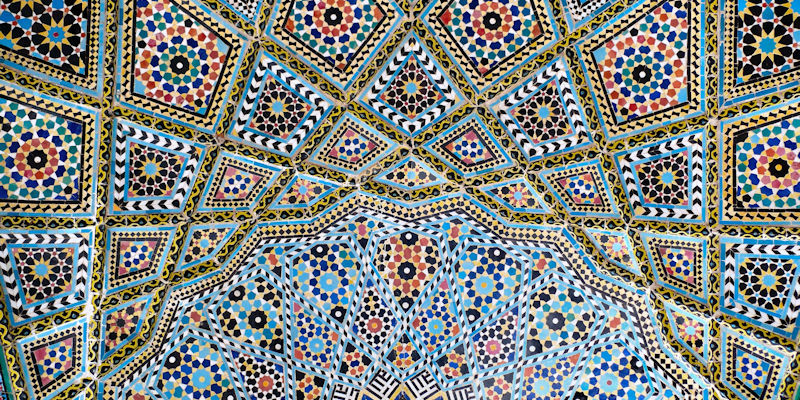
Preservation of Tile Art in Iran
Despite challenges, efforts are underway in Iran to preserve this ancient art form. Conservationists and artisans work hand in hand to maintain the legacy of Iranian tiles.
Iranian Tiles in Interior Design
Today, Iranian tiles are making a resurgence in interior design, blending traditional art with modern aesthetics. They add a timeless elegance to any space they adorn.
The Process of Creating Iranian Tiles
The creation of these tiles is a labor of love, involving careful selection of materials and meticulous handcrafting by skilled artisans.
Challenges and Future of Iranian Tile Industry
The Iranian tile industry faces economic and political challenges, but its future looks promising as it adapts to changing trends while preserving its heritage.
Comparing Iranian Tiles with Other Cultural Tile Arts
Iranian tiles, while unique, share similarities with other cultural tile arts. This comparison reveals a rich tapestry of global artistic traditions.
The Role of Iranian Tiles in Cultural Identity
For Iranians, tiles are more than artistic creations; they are symbols of national identity and pride, embodying centuries of cultural evolution.
Acquiring Iranian Tiles
For those interested in owning a piece of this history, several avenues exist to purchase authentic Iranian tiles, supporting the local artisans.
Maintenance and Care of Iranian Tiles
Maintaining these tiles involves specific care techniques, ensuring they continue to beautify spaces for years to come.
Furniture and curtains with Persian tiles designs
Fabrics with Persian tile designs turn furniture into luxurious works of art. They bring a sense of originality to your living room. Their vibrant colors can make the space look more unique. Curtains are also an influential element. You can make them from fabrics with Iranian patterns and hang them like frames of valuable artwork.
If you use curtains with Persian tile designs, it’s better to choose simple sofas. Or do the opposite: use patterned furniture with plain curtains. Combining too many patterns can make the room feel crowded and distract from the designs. So, use traditional patterns on one or two main elements. Match the rest of the space only by color, and keep their designs simple.
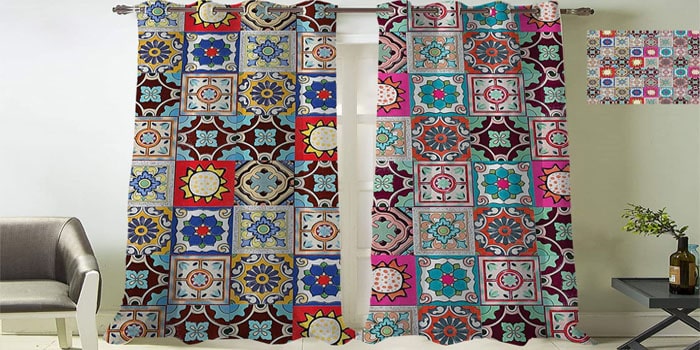
curtains with Persian tile designs
F&Q
- What changes have Persian tiles undergone throughout history?
With the passage of years of Iranian civilization, the models and types of Persian tiles have also made significant progress. In every period of history, according to the beliefs and popular culture of the people. The models of ceramic and tiles and the type of tiling are also inspired by them. Therefore, the design of traditional tiles is different in different periods. - Is tiling an art? Yes. Tiling and its designs in traditional tile are considered a beautiful art that you can have as a work of art, and you can learn this art.
- How to use Persian tiles designs? You can use various Persian tile designs as decorative wall tiles, tabletops, or even incorporate them into fabrics and tableaus.







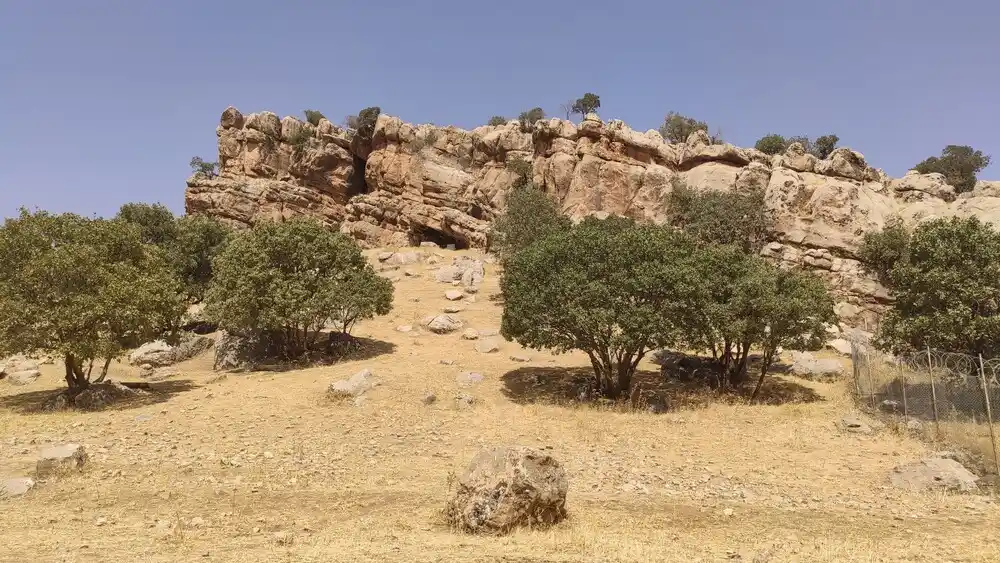
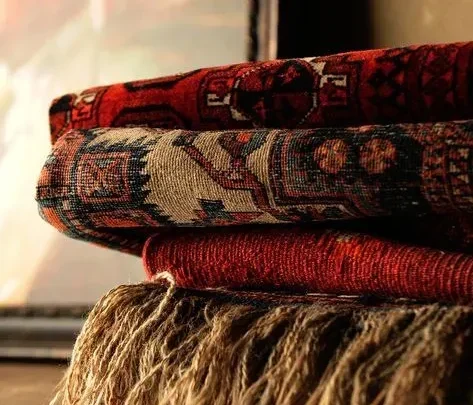

Comments